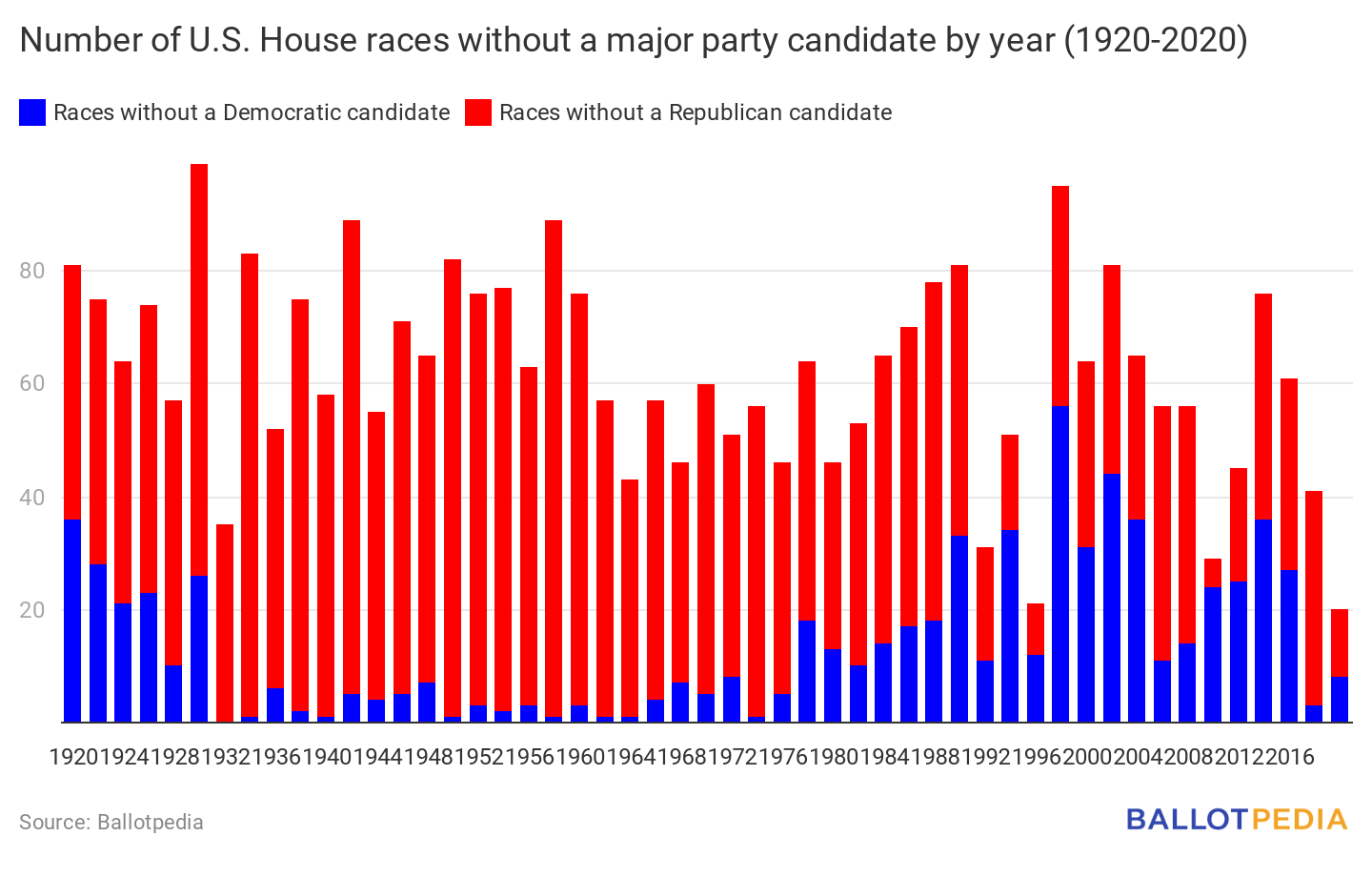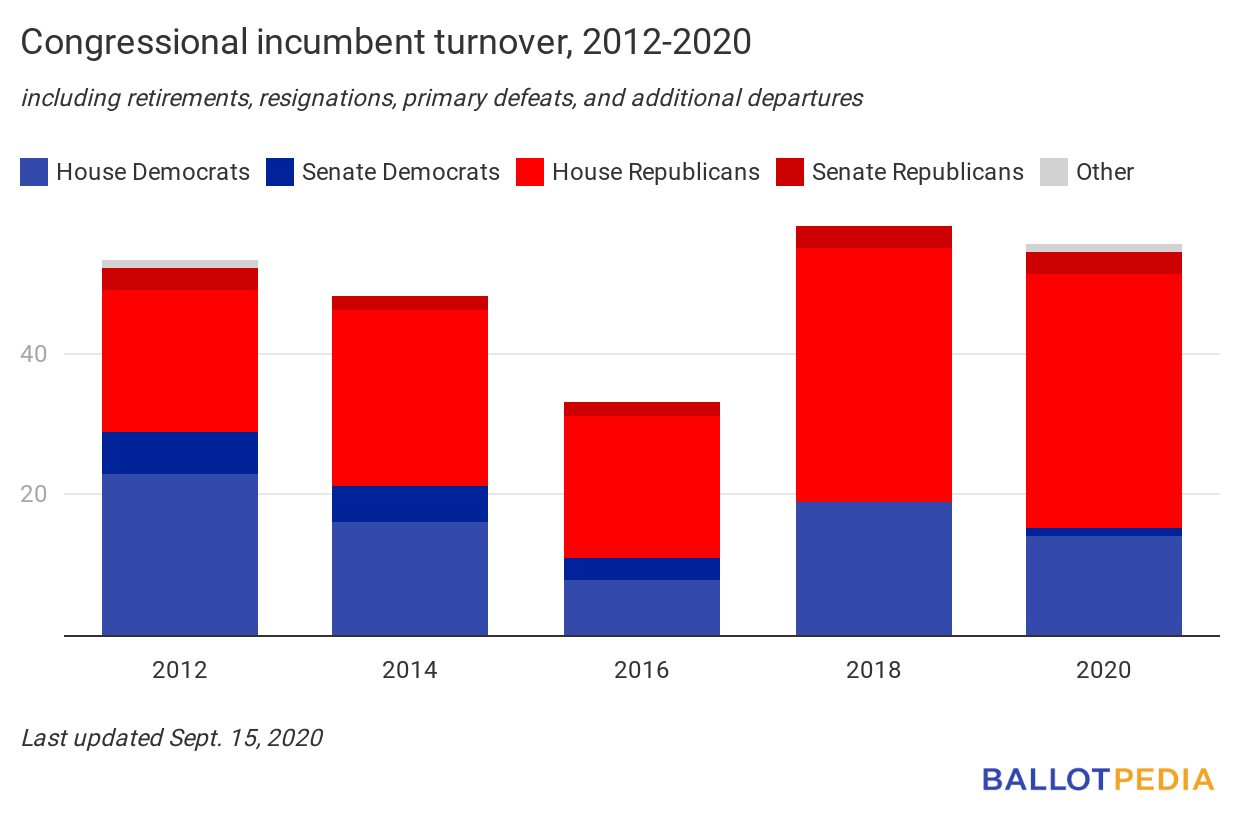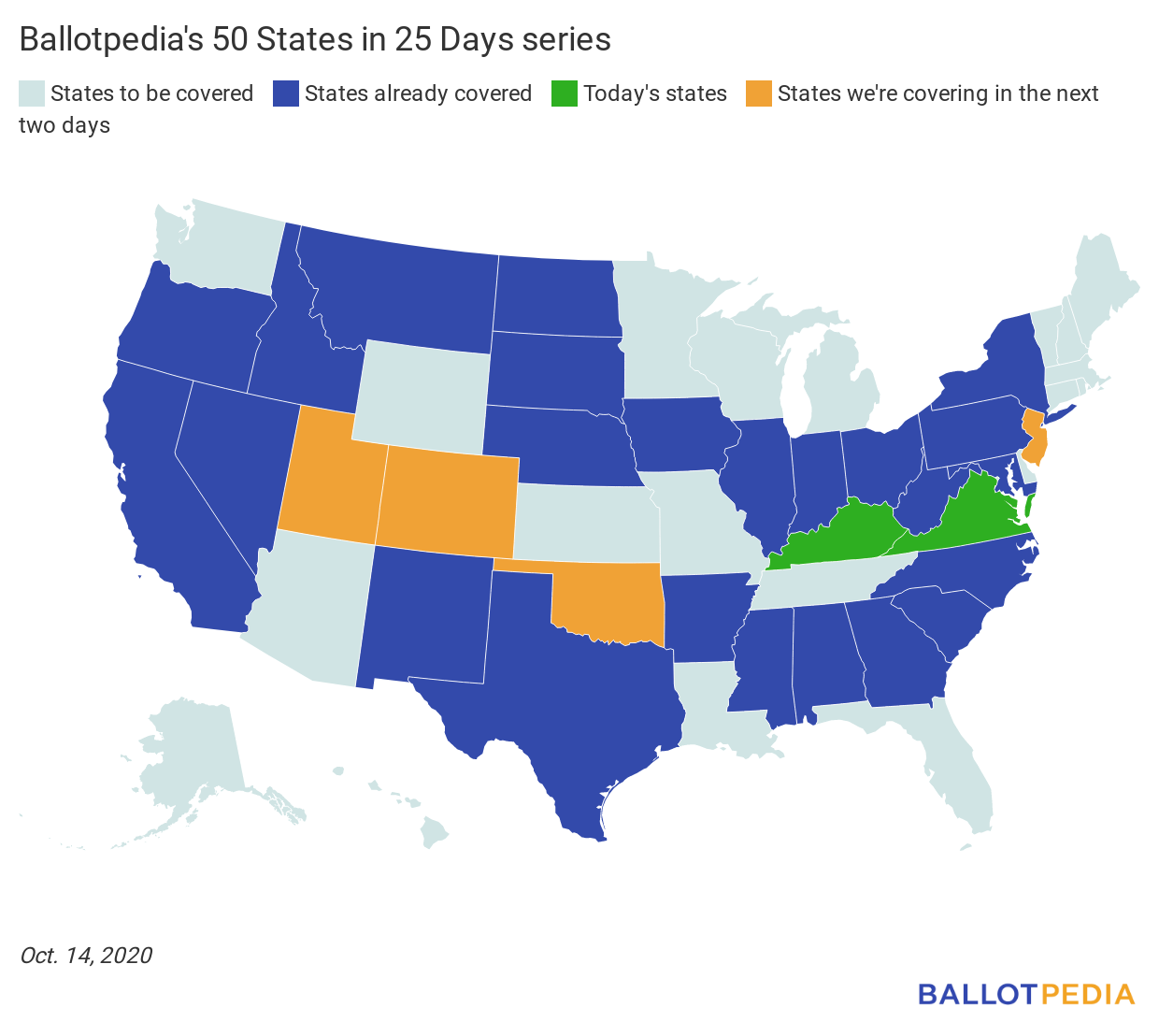|
|
|
|
Welcome to the Wednesday, October 14, Brew. Here’s what’s in store for you as you start your day:
- 95% of U.S. House elections feature candidates from both major parties
- Senate Judiciary Committee hearings continue on Amy Coney Barrett’s nomination to Supreme Court
- Explore Kentucky elections
- Explore Virginia elections
|
95% of U.S. House elections feature candidates from both major parties
Ballotpedia’s annual study of competitiveness in congressional races finds that 95.4% of U.S. House elections this year—415 of 435—feature candidates from both major parties. This is an increase from the four preceding election cycles and the highest rate of contested races since at least 1920.
Only 20 U.S. House races feature candidates from just one of the two major parties. Democrats are running in 12 races without Republican competition and Republicans are running in eight without Democratic opponents.
The chart below shows the number of U.S. House races without a major-party candidate from 1920 to 2020. Blue bars indicate the number of races without a Democratic candidate and red bars display the number of races without a Republican candidate.

Our Annual Congressional Competitiveness Report also examines the 55 congressional races without an incumbent this year:
- 45 open seats—four in the Senate and 41 in the House—where the incumbent did not seek re-election
- Eight incumbents who were defeated in primaries or nominating conventions
- Two U.S. House vacancies.

Our report includes even more analysis, such as a look at the influence of presidential elections and Pivot Counties on the number of open seats in congressional races. Ballotpedia identifies Pivot Counties as those that voted for Donald Trump in 2016 after voting for Barack Obama (D) in 2008 and 2012.
There’s so much information (and charts and maps!) in this report that I had a hard time deciding what to include here in the Brew. I know you’re going to want to explore all this data on your own—click the link below to get started!
|

|
Senate Judiciary Committee hearings continue on Amy Coney Barrett’s nomination to Supreme Court
The Senate Judiciary Committee will hold its third day of hearings regarding the nomination of federal appeals court justice Amy Coney Barrett to the U.S. Supreme Court. Those hearings began Oct. 12 and are expected to continue all week.
President Donald Trump (R) nominated Barrett on Sept. 29 to fill the vacancy created by the death of Associate Justice Ruth Bader Ginsburg on Sept. 18. Barrett was appointed to the United States Court of Appeals for the 7th Circuit in 2017 by Trump. She previously clerked for Supreme Court Justice Antonin Scalia and Judge Laurence Silberman of the U.S. Court of Appeals for the D.C. Circuit.
Our coverage includes a brief summary of each day’s proceedings as well as links to official committee documents, such as the opening statements made by the members of the Judiciary Committee and Barrett's completed committee questionnaire. Bookmark the link below to stay on top of what’s happening.
Learn more→
|
Explore Kentucky elections
After we preview today’s states—Kentucky and Virginia—in our 50 States in 25 Days series, we will have covered 26 states. We are halfway there on our journey through the country! In case you missed any, here are links to the states we’ve already covered and a map showing what’s coming up:
Week One: Alabama, Arkansas, California, Texas, North Carolina, Mississippi, Illinois, Ohio, Nebraska, and Oregon
Week Two: Montana, New Mexico, Iowa, South Dakota, Indiana, Pennsylvania, Idaho, Maryland, Nevada, and South Carolina
Week Three: North Dakota and West Virginia, Georgia, and New York

On the ballot in Kentucky
At the federal level, Kentucky voters will elect eight presidential electors, one U.S. Senator, and six U.S. Representatives. Both chambers of the state legislature are on the ballot, with 19 out of 38 seats in the state Senate and all 100 state House districts up for election. One seat on the state supreme court and one intermediate appellate court seat are on the ballot. Voters will also decide on two statewide ballot measures. Ballotpedia is tracking local elections in Lexington, Louisville, Fayette County, and Jefferson County.
Partisan data
- In 2016, Donald Trump (R) defeated Hillary Clinton (D) 63% to 33% in Kentucky. Bill Clinton (D) was the last Democrat to win the state in a presidential election in 1996.
- One of Kentucky’s 120 counties—Elliott County—is a Pivot County. Pivot Counties voted for Barack Obama (D) in 2008 and 2012, then Donald Trump (R) in 2016.
- Both of Kentucky’s U.S. Senators—Mitch McConnell and Rand Paul—are Republicans.
- Republicans represent five of the state's U.S. House districts and Democrats represent one.
- Kentucky’s governor is a Democrat while its attorney general and secretary of state are Republicans, meaning it is one of 14 states without a state government triplex. Democrats had the state's last triplex, which was broken in 2015 when Matt Bevin (R) was elected governor. Democrat Andy Beshear was elected governor in 2019.
- Republicans have a 28-10 majority in the state Senate and a 62-38 majority in the state House. Because the governor is a Democrat, Kentucky is one of 14 states without a trifecta. Kentucky's Republican trifecta was broken when Andy Beshear (D) was elected governor in 2019.
Battleground races
Ballotpedia has identified one battleground race in Kentucky this year:
- U.S. Senate: Senate Majority Leader Mitch McConnell (R), Amy McGrath (D), Brad Barron (L), and Randall Lee Teegarden (Unaffiliated) are running for one of Kentucky’s seats in the U.S. Senate.
Ballot measures
- Kentucky voters will decide two measures on Nov. 3. The legislature referred both constitutional amendments to the ballot.
- Constitutional Amendment 1 would add specific rights of crime victims, together known as Marsy's Law, to the Kentucky Constitution. Kentucky voters approved a Marsy's Law amendment in 2018 63% to 37%, but it was overturned in KACDL v. Grimes and Board of Elections. As of May 2020, 14 states had passed a ballot measure for Marsy's Law. The first was in California in 2008.
- Constitutional Amendment 2 would extend the office terms of circuit court clerks, commonwealth's attorneys, county attorneys, and district judges. It would also change licensing requirements.
Voting
- In response to the coronavirus pandemic, Gov. Andy Beshear (D) and Secretary of State Michael Adams (R) announced that absentee/mail-in voting eligibility would be extended to all "Kentuckians concerned with contracting or spreading COVID-19."
- Witnesses or notaries are not required to sign absentee or mail-in ballot documents in Kentucky.
- Absentee/mail-in ballots can be returned in person or by mail. If returned in person, ballots must be received by 6 p.m. on Nov. 3. If returned by mail, ballots must be postmarked on or before Nov. 3 and received by Nov. 6. Click here to check the status of your ballot.
- In the 2018 general election, mail-in ballots made up 1.5% of the total vote.
- Kentucky law provides for absentee/mail-in ballot processing to begin at 8 a.m. on Election Day. The relevant statutes specify that counting begins after all ballots have been processed.
- Kentucky requires all voters to present non-photo identification at the polls. For more information about Kentucky's voter ID requirements, click here.
- Kentucky's early voting period opens on Oct. 13 and closes on Nov. 2.
- In Kentucky, polls are open from 6 a.m. to 6 p.m. on Election Day. Kentucky is split between the Eastern and Central time zones.
|
Explore Virginia elections
On the ballot in Virginia
At the federal level, Virginia voters will elect 13 presidential electors, one U.S. Senator, and 11 U.S. Representatives. There is one special election for a seat in the House of Delegates. Voters will also decide two statewide ballot measures. Ballotpedia is tracking local elections in Richmond and Virginia Beach.
Partisan balance
- In the 2016 presidential election, Hillary Clinton (D) defeated Donald Trump (R) 50% to 44% in Virginia. Virginia voted for the Democratic nominee for president in 2012 and 2008. It voted for the Republican nominee in each election from 1968 to 2004.
- Virginia is one of 34 states with at least one Pivot County. Pivot Counties voted for Barack Obama (D) in 2008 and 2012, then voted for Donald Trump (R) in 2016. Virginia has five such counties.
- Both of Virginia's U.S. Senators—Mark Warner and Tim Kaine—are Democrats.
- Democrats represent seven of Virginia's U.S. House districts and Republicans represent four.
- Virginia's governor and attorney general are Democrats, and the governor appoints the secretary of the commonwealth. This means it is one of 17 states with a Democratic triplex. It has held this status since 2014.
- Democrats have a 21-19 majority in the state Senate and a 55-44 majority in the House of Delegates. Since Virginia's governor is a Democrat, it is one of 15 Democratic trifectas. Democrats gained a trifecta when they won control of both chambers of the General Assembly in the 2019 elections.
Battleground races
There are three battleground races in Virginia in 2020:
- Virginia's 2nd Congressional District: Incumbent Elaine Luria (D), Scott Taylor (R), and David Foster (I) are running. Luria defeated then-incumbent Taylor 51% to 49% in 2018.
- Virginia's 5th Congressional District: Cameron Webb (D) and Bob Good (R) are running. Good defeated incumbent Denver Riggleman at the Republican convention. Riggleman defeated Leslie Cockburn (D) 53% to 47% in 2018.
- Virginia's 7th Congressional District: Incumbent Abigail Spanberger (D) and Nick Freitas (R) are running. Spanberger was first elected in 2018 after defeating incumbent David Brat (R) 50% to 48%. Before that, a Republican had represented the district since 1971.
Ballot measures
- Virginia voters will decide two statewide measures on Nov. 3. The General Assembly referred both constitutional amendments to the ballot.
- One measure would create a redistricting commission to draw congressional and state legislative districts.
- The other measure would exempt one motor vehicle owned by a totally disabled veteran from property taxes.
Voting
- In response to the coronavirus pandemic, Gov. Ralph Northam (D) signed into law legislation providing for the use of drop-boxes to return absentee/mail-in ballots. The enacted legislation also provided for prepaid return postage.
- Witnesses or notaries are not required to sign absentee or mail-in ballot documents in Virginia.
- Absentee/mail-in ballots can be returned in person or by mail. If returned in person, ballots must be received by Nov. 3. If returned by mail, ballots must be postmarked on or before Nov. 3 and received by Nov. 6. Click here to check the status of your ballot.
- In the 2018 general election, mail-in ballots made up 2.8% of the total vote.
- Virginia law says that absentee/mail-in ballots cannot be counted until Election Day.
- Virginia requires all voters to present non-photo identification at the polls. For more information about Virginia's voter ID requirements, click here.
- In Virginia, early voting opened on Sept. 18 and runs through Oct. 31.
- In Virginia, polls are open from 6 a.m. to 7 p.m. on Election Day. Virginia is in the Eastern time zone.
|
|
Ballotpedia depends on the support of our readers.
The Lucy Burns Institute, publisher of Ballotpedia, is a 501(c)(3) nonprofit organization. All donations are tax deductible to the extent of the law. Donations to the Lucy Burns Institute or Ballotpedia do not support any candidates or campaigns.
|
|
|
|
|